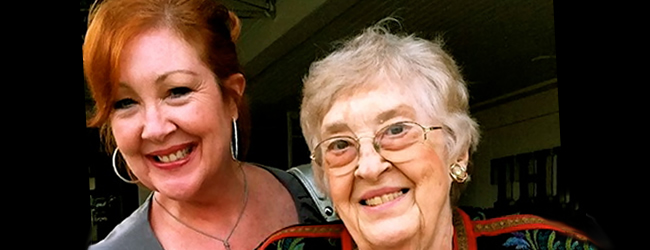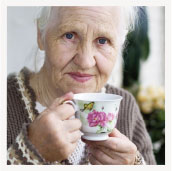 Crafted from fine cotton yarn, the black cardigan sweater became a staple in my spring wardrobe after my mother bought it for me 10 years ago. Rediscovering it in the back of my closet last week, I suddenly recalled a happier memory of Mom—a time when I wasn’t overwhelmed by what social workers describe as “caregiver burnout.” And then came an unexpected flood of tears.
Crafted from fine cotton yarn, the black cardigan sweater became a staple in my spring wardrobe after my mother bought it for me 10 years ago. Rediscovering it in the back of my closet last week, I suddenly recalled a happier memory of Mom—a time when I wasn’t overwhelmed by what social workers describe as “caregiver burnout.” And then came an unexpected flood of tears.
It’s not like me to fall apart over a sweater while I’m reorganizing my closet for a new season. But then again, my mother hasn’t been herself for several seasons, either. Things began to unravel after my son left for college—just when my husband and I were starting to enjoy the freedom of our newly emptied nest.
First, we noticed Mom was showing up at family gatherings with burns and bruises she couldn’t explain. Then her friends would call to report that she’d forgotten to show up for club meetings and lunch dates. She’d drive herself to the ER during her panic attacks, which started occurring with alarming frequency. Not long afterward, her doctors told me to confiscate her car keys. Mom was 79 and had been widowed for 16 years when she was officially diagnosed with vascular dementia. She was also battling heart disease and severe hearing loss. As her only child, I was handed full responsibility of her medical care along with a checklist outlining her worrisome diagnosis.
At the time, Mom lived alone in a condo near my house. She refused to consider any type of senior housing, regardless of the fact that she’d been in and out of the hospital half a dozen times, and averaged 45 medical visits annually. But no matter how tactfully I approached the topic of assisted living—and offered to schedule tours of the best facilities—she’d look at me as if I’d asked her to move to the Outer Hebrides with nothing but a toothbrush. She insisted she was “perfectly capable” of caring for herself at home. And so, at least for a while, I ended up managing her care. Driving daily to her condo, I dispensed her medications and checked on her safety. I hired a home-care nurse and a Helping Hands companion from the local hospital. Saddest of all is the fact that dementia robbed Mom’s interest in almost everything she once enjoyed—Early American history, needlework, reading, lunch with friends. And clothes shopping.
In her prime, Mom had elevated bargain shopping to an art form, taking pleasure in scouting for gifts for people she loved. Even when I reached middle age, she’d insist on purchasing a new item of clothing for me whenever the seasons changed. Which brings me back to the black sweater. Ten years ago, Mom knew I’d been hunting for such a sweater—a classic black cardigan that would bridge the seasons. I’d shopped at several stores in two malls, but with no luck. I’d nearly given up when I discovered a shopping bag hanging from the side door of my house one afternoon. In it was the perfect black cotton sweater, which Mom had found on sale at one of her favorite haunts. When I rediscovered the sweater last month, my unexpected tears released a tsunami of mixed emotions.
Until then, I’d been raging inwardly at the dementia that had devoured my mother’s mind and rendered her incapable of making her own decisions. I hadn’t fully realized that I was grieving the loss of my “real” mother—the woman who had shared her wisdom and recipes, encouraged my career, babysat my son, and took delight in buying me new clothes. These days, I learn everything I can about my mother’s health problems and advocate for her 24/7. I’ve also learned to guard my own health—and my time—knowing that Mom depends on my strength now. Meanwhile, the black sweater serves as an emblem of my mother’s best years; a tangible reminder of her former self and the special friendship we’ve shared. It’s a comfort to wear it.
Cindy La Ferle is author of a memoir, Writing Home, and blogs about midlife and caregiving issues at www.laferle.com





